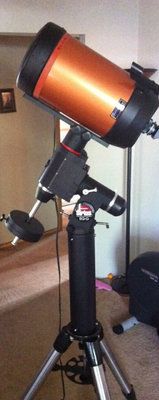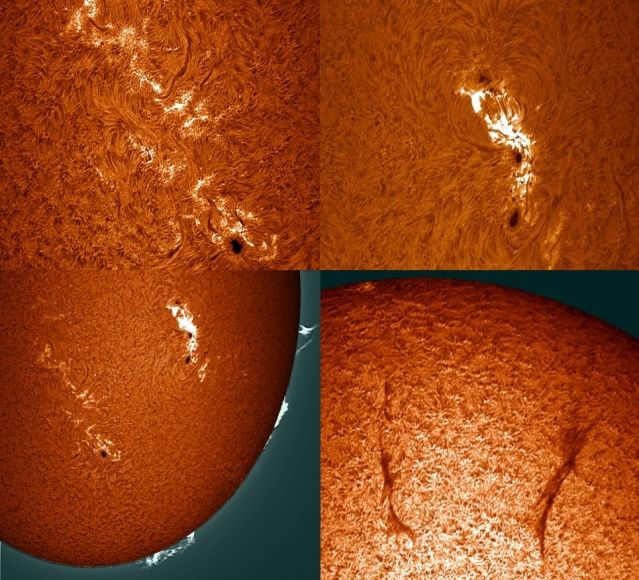Sunday, July 29, 2012
EQMOD Scope control demo from tonight 7/28
Saturday, July 28, 2012
Lots of changes
Last week I traded my beloved Lunt 60 solar scope. I loved that little scope, but I decided to trade for a mount more suitable for AP work. After we cycle down from the solar maximum, I will pick up a used PST to satisfy my urge for solar imaging. I ended up trading for an Orion Sirius EQ-G (little brother to Atlas mount) with a deforked fastar-compatible C8 with starbright coatings. Also included was the Celestron pelican case and cases for everything else. I got tons of accessories and netbook to control the mount/scope via EQMOD/EQASCOM. The mount itself is only 7 months old and used a handful of times.
I swapped out the tripod (1.75"OD legs) with the sturdier tripod (2.0"OD legs) from the CG-5 asgt mount. I ordered and installed the Orion 16" SVP Pier extension, which is compatible with both tripods. After learning how to polar align the cg-5, I decided I wasn't going to crawl on the ground anymore. I must admit, with the scope and mount attached to the pier extension, it is quite a formidable setup.
I swapped out the tripod (1.75"OD legs) with the sturdier tripod (2.0"OD legs) from the CG-5 asgt mount. I ordered and installed the Orion 16" SVP Pier extension, which is compatible with both tripods. After learning how to polar align the cg-5, I decided I wasn't going to crawl on the ground anymore. I must admit, with the scope and mount attached to the pier extension, it is quite a formidable setup.
Another shot of the "Twins":
I put the trade scope on the CG-5 ASGT mount and plan to use for visual use or planetary imaging while I do my DSO subs with the NS8SE OTA on the Sirius mount.
About the Sirius mount. There sure isn't as much review information on the internet as it's big brother, the atlas. The motors and controls are the same, however the payload limit of this system is rated at 30lbs. I figure my OTA with eventual guidescope package and imager will place it between 16-18 lbs depending on the imager used. A little over half of the visual rating, it means I will have to give extra attention to balancing if I plan to be successful with AP. I am also thinking real seriously about going the hyperstar route next year at tax time.
The motors on the Sirius mount are amazingly quiet when compared to my CG-5. The CG-5 is pretty loud, and although it never really bothered me before, compared to the Sirius I can see where they can get annoying. The mount was purchased originally without a hand controller, so I connect to the mount using EQMOD/EQASCOM and sync goto's with Cartes du Ciel. I really didn't like CdC at first, being familiar with stellarium and all, but I have to admit that it has grown on me. Uncle Rod pointed me in the right direction to get it setup in a similar fashion to stellarium.
About EQMOD. This program is simply amazing, giving me much more control and trouble-free operation than NexRemote ever could. It is a bit of informational overload, due to the never-ending list of features. The trick is to take several nights and take small bites, rather than try to chew on it all at once. I took several nights learning different features and over the course of last week, I feel pretty confident in using it. I downloaded the voicepack and installed it so now the mount talks to me when operating. Audible alerts and announcements are completely customizable, allowing any sound or .wav to be assigned to nearly every aspect of mount/scope operation. I am currently compiling some star trek computer sounds to plug in, because yes, I am that big of a nerd. I will say this about EQMOD, it is light-years ahead of NexRemote.
So my plans are, for the moment...to sell the Nexstar 8 altaz mount (350 with manual, nexremote software, HC extender, HC, computer/hand control cable, no power cord) and purchase an Orion SSAG package. I also plan on selling my DMK21 monochrome imager (300) and purchasing the color equivalent DFK/DBK21 for planetary imaging (since only needed monochrome for h-alpha imaging).
Tonight will be first light with this new setup. Hoping for clear skies and good luck!
Wednesday, July 4, 2012
Sunday, July 1, 2012
Solar Goodness and First Light with CG-5 ASGT
Yesterday turned out to be a really good day. I woke up and took immediate note of the swaying tree in the front yard and determined that it would probably be too windy to try for any solar imaging. As I got around, I logged online to see some amazing prominence shots on the GONG h-alpha solar monitor site. I decided to brave the wind, and I am glad that I did. Imaging yesterday gave me a stress-free day (no transit, no public outreach) to really experiment and play with the IC capture software that came with the DMK-21. As such I think I found a sweet spot on the gamma slider bar where the darker, contrasty details really pop out at you. I did some imaging, and active regions AR1515 and 1513 took the cake. I was amazed out how much detail I was able to get with the DMK and the single-stack Lunt 60tha.
After processing the above images, I became keenly aware that it was saturday evening and I was very bored, and very broke. I decided to give my Celestron CG-5 ASGT mount a try. I didn't really have the energy for a full blown imaging session, and I believe the moon was at 91 percent illumination anyway. Honestly I just didn't have the energy to drag out all the apparatus necessary. I decided to make it a visual session only, that would give me time to figure out polar alignment. You see, I have read many a manual and tutorial, but have never actually done a polar alignment routine. I dragged the behemoth out side, set the correct leg to North, and began the procedure just as soon as I could see Polaris. Turns out, alignment was a snap with the polar scope. What I didn't like though, was that in order to get the optics perfectly aligned, I had to fudge a little from the index marks. I will look into this more, I was kinda flying by the seat of my pants. After everything was aligned, I went to work. One thing that I will say is that it sure was different to align a GEM mount than the alt-az. I like being able to choose which stars I align to, my choice this time of year being Vega and Spica. The mount forced me to choose between western stars, then I could add eastern calibration stars. Not to bad, just different. I chose Spica and Alkaid, then added Vega as a calibration star and I was off to the races. First target: Albiero. Next target: M57. All of my gotos were off, but I attribute this to a.) index mark change in home position during initial startup (error due to my inexperience) and b.) pitiful power cord and partially charged battery. I did have a runaway goto indicative of a low voltage problem, but as mentioned above, the power cord is the weak link here and I have observed about 5 sessions on my power tank, so I know it has to be about done. I mean, the gotos were not that bad off, just usually slightly out of the FOV on the top of the eyepiece.
Other impressions? This mount seems rock solid. Some old salts will probably laugh at that statement, as one of the chief complaints of the mount is that it isn't very solid. My experience coming from the NexStar 8SE with it's overworked mount and 1.50" skinny tripod legs. The ASGT with the 2" tripod legs makes a huge difference. Vibrations dampened quickly, and I was actually able to focus manually with out using four-letter words and waiting on the vibrations to settle down. If this mount seems rock solid, I cannot wait to see what the Orion Atlas is like.
To sum up, I was very pleased with the first performance of this mount. Tracking seemed dead-on, nothing appeared to travel in the eyepiece (true test will be photography). Setup is a bit more involved, but really only slightly so. My problems with gotos are probably user error or power deficiency. I can live with that.
Subscribe to:
Posts (Atom)







